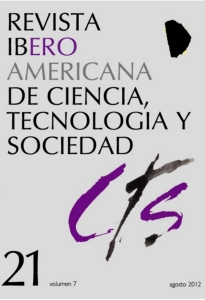Scientific research in Ibero-America (1982-2011)
A bibliometric study
DOI:
https://doi.org/10.52712/issn.1850-0013-672Keywords:
Ibero-America, scientific production, evolution, collaborationAbstract
This article aims to analyse the participation of Ibero-American (Spanish and Portuguese speaking) countries in the international scientific literature, as well as its evolution, its collaboration with non Ibero-American scientists and institutions, with an emphasis on the role of Spain in the Ibero-America scientific scenario. During the period of time that was considered, Brazil has participated in 45% of the total Ibero-American publications, with a continuous increasing growth: since 2007 this participation raised to above 50%. The most productive institution is the University of Sao Paulo. As expected, scientists from the United States are the most commonly found as co-authors in publications with Ibero-American authors (13%), followed by those from Spain, France and the United Kingdom. Similarly, the non-Ibero-American organization with the highest presence is the University of California, followed by the Spanish Consejo Superior de Investigaciones Científicas. It is also remarkable that some of the most cited publications of Ibero- American co-authors have scientists from Spain as corresponding authors.
Downloads
References
BANCO MUNDIAL (2011): Datos. Disponible en: http://datos.bancomundial. org/indicador.
BERENDSEN, H. J. C., GRIGERA, J. R., y STRAATSMA, T. P. (1987): “The Missing Term in Effective Pair Potentials”, Journal of Physical Chemistry,vol. 91, n° 24, pp. 6269-71.
BLATTNER, F. R. ET AL (1997): “The complete genome sequence of Escherichia coli K-12”, Science,vol. 277, n° 5331, pp. 1453-62.
BOSCH, F. X. ET AL (1995): “Prevalence of Human Papillomavirus in Cervical-Cancer - a Worldwide Perspective”,Journal of the National Cancer Institute, vol. 87, n° 11, pp. 796-802.
BRUZUAL, G. y CHARLOT, S. (2003): “Stellar population synthesis at the resolution of 2003”,Monthly Notices of the Royal Astronomical Society,vol. 344, n° 4, pp. 1000- 28.
CENTER FOR WORLD-CLASS UNIVERSITIES (2012): “Academic Ranking for World Universities”. Disponible en: http://www.arwu.org/.
JONES, T. C. ET AL (1987): “Epidemiology of American Cutaneous Leishmaniasis Due to Leishmania-Braziliensis-Braziliensis”, Journal of Infectious Diseases, vol. 156, n° 1, pp. 73-83.
LEMARCHAND, G. A. (2010): Sistemas nacionales de ciencia, tecnología e innovación en America Latina y el Caribe,Montevideo, Oficina Regional de Ciencia y Tecnología para América Latina y el Caribe, UNESCO.
MALMSTROM, K. ET AL (1999): “Oral montelukast, inhaled beclomethasone, and placebo for chronic asthma - A randomized, controlled trial”, Annals of Internal Medicine,vol. 130, n° 6, pp. 487-95.
MULLAN, F. (2005): “The metrics of the physician brain drain”, NEngl J Med,vol. 353, n° 17, pp. 1810-8.
MUÑOZ, N. ET AL (2003): “Epidemiologic classification of human papillomavirus types associated with cervical cancer”, New England Journal of Medicine,vol. 348, n° 6, pp. 518-27.
OBSERVATORIO IBEROAMERICANO DE LA CIENCIA, LA TECNOLOGÍA Y LA SOCIEDAD (2009): Grandes instalaciones científicas en Iberoamérica. Disponible en: www.observatoriocts.org.
PELLEGRINO, A. (2001): “Trends in Latin American Skilled Migration: ‘Brain Drain’ or ‘Brain Exchange’?” International Migration,vol. 39, n° 5, pp. 111-32.
POUNDS, J. A. ET AL (2006): “Widespread amphibian extinctions from epidemic disease driven by global warming”, Nature,vol. 439, n° 7073, pp. 161-7.
RADI, R. ET AL (1991): “Peroxynitrite Oxidation of Sulfhydryls - the Cytotoxic Potential of Superoxide and Nitric-Oxide”, Journal of Biological Chemistry,vol. 266, n° 7, pp. 4244-50.
RIESS, A. G. ET AL (1998): “Observational evidence from supernovae for an accelerating universe and a cosmological constant”, Astronomical Journal,vol. 116, n° 3, pp. 1009-38.
RUIZ-PALACIOS, G. M. ET AL (2006): “Safety and efficacy of an attenuated vaccine against severe rotavirus gastroenteritis”, New England Journal of Medicine,vol. 354, n° 1, pp. 11-22.
SCIMAGO (2011): “SCImago Journal & Country Rank”. Disponible en: http://www.scimagojr.com.
SEN, A. K. (2000): Desarrollo y Libertad,Barcelona, Planeta.
THE TIMES HIGHER EDUCATION RANKINGS (2012): “The World University Rankings 2011-2012”. Disponible en: http://www.timeshighereducation.co.uk/world- university-rankings/2011-2012.
UNITED NATIONS DEPARTMENT OF ECONOMIC AND SOCIAL AFFAIRS (2012): “World Population Prospects, the 2010 Revision”. Disponible en: http://esa.un.org/unpd/wpp.
VILLA, L. L. ET AL (2007): “Quadrivalent vaccine against human papillomavirus to prevent high-grade cervical lesions”, New England Journal of Medicine,vol. 356, n° 19, pp. 1915-27.
Downloads
Published
How to Cite
Issue
Section
License
Copyright (c) 2024 CC Attribution 4.0

This work is licensed under a Creative Commons Attribution 4.0 International License.
All CTS's issues and academic articles are under a CC-BY license.
Since 2007, CTS has provided open and free access to all its contents, including the complete archive of its quarterly edition and the different products presented in its electronic platform. This decision is based on the belief that offering free access to published materials helps to build a greater and better exchange of knowledge.
In turn, for the quarterly edition, CTS allows institutional and thematic repositories, as well as personal web pages, to self-archive articles in their post-print or editorial version, immediately after the publication of the final version of each issue and under the condition that a link to the original source will be incorporated into the self-archive.











